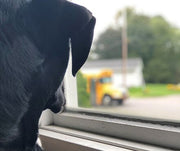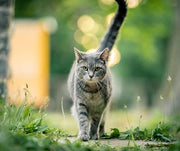How to Transition to a New Dog or Cat Food

Switching your pet over to a new food is sometimes necessary in keeping your furry friend as healthy as can be. Sometimes a switch in pet food may need to happen for reasons such as allergies, your pet needing to lose or gain weight, or your pet transitioning to a new life stage (such as an adult to a senior). Your veterinarian may also suggest a change in food for other reasons. Whatever the case, switching your dog or cat to a new type of food can be a challenge, but keep reading for tips on how to make this transition as smooth as possible.
HOW TO TRANSITION TO A NEW FOOD
When it comes to switching your pet over to a new type of food, the first thing to remember is that you should not immediately switch your pet over to new food all at once. There are a number of reasons why you'll want to avoid this. If they've been eating the same type of food for several years, switching suddenly to something new could upset their digestive system. There is also a possibility that they won't be interested in or won't initially like their new food, and, in turn, refuse to eat. It can be hard for some dogs and cats to deal with abrupt changes, so keeping them comfortable and ensuring a gradual transition should be a priority.
You'll want to transition your dog or cat to a new food slowly but consistently so that they can get used to it over time. Below is a good schedule to try and follow as you're starting this transition:
- Days 1-3: Start the first 3 days by giving your pet 3 parts old food and 1 part new food. This gives them a good taste of their new food while still allowing them to eat a majority of food they are used to.
- Days 4-6: On days 4-5, switch to 2 parts old food and 2 parts new food. At this stage, your dog or cat will have half old food and half new food.
- Days 7-10: During the next 3 days, you'll give your pet 1 part old food to 3 parts new food. Your pet will now have more new food than old food.
- Day 11: Finally, on day 11, you'll give your pet 100% new food!
Why use this schedule? As stated earlier, giving your pet a slower transition to new food will allow their digestive system plenty of time to adjust so that you can hopefully avoid any issues that will make your pet uncomfortable.
However, be sure you're monitoring your pet as you're in the process of switching out their food with something new. Here are a few specific side effects you should be aware of and monitor:
- Dehydration: Not sure if your pet is dehydrated? It might not be pleasant, but pay attention to their poop. If it's dry and hard, it may be a sign that your pet is dehydrated. Also be on the lookout for symptoms such as sunken eyes, loss of skin elasticity, and fatigue. As you're switching over to a new food, make sure that you keep plenty of water on hand for your cat or dog so that they stay hydrated as their body is adjusting. You may also want to try using an automatic water dispenser for your pet, which can help attract them to their water dish!
- Blood in stool: Speaking of your pet's poop, if you notice blood in their feces, be sure to contact a vet so that you can figure out the issue. There are a number of reasons why your dog or cat may have blood in their stool, but you'll want to work with a vet to rule out anything serious. Sometimes, it can be a sign of constipation. It can also be a sign of an allergy, so if you notice this after transitioning them over to a new food, you may need to switch back to their old food until your speak with a vet and figure out the problem.
- Low energy: Is your dog or cat more sluggish than usual as you've been transitioning them to a new food? As stated above, this could be a sign of dehydration, so be sure you're providing enough water for your dog or cat. Be sure to keep an eye on how much they are eating, as well. Low energy could be a result of them not wanting to each much of their new food. If this is the case, switch back to their old food so that they will stay nourished and won't go hungry. Also, consider a slower transition to their new food (more on that below).
- Diarrhea: Because your furry friend's digestive system likely isn't used to eating something new on a daily basis, it's normal for them to experience some diarrhea as their digestive tract is adjusting. Most of the time, this will resolve itself. However, be sure you're keeping an eye on it. If it continues to persist, or if you notice blood, be sure to speak with your vet.
If your dog or cat experiences any of these symptoms as you're transitioning them to a new food, you may want to back up and start slower. For example, you may want to try giving your pet only 1/8th of their new food and 7/8ths of their old food to transition them at a slower pace. You may also want to consult your vet and discuss options of different foods to try if your pet does not seem to be adjusting well. Trying out new feeding and watering options might also give them more interest in eating.
As always, monitor your pet and reach out to your vet if any concerns arise so that you can keep your pet as happy and as healthy as can be!
Sources:
- https://be.chewy.com/transitioning-your-pet-to-a-new-food-tips-to-ensure-success/
- https://www.petco.com/content/petco/PetcoStore/en_US/pet-services/resource-center/food-nutrition/how-to-transition-your-dog-or-cat-to-a-new-food.html
- https://www.akc.org/expert-advice/nutrition/right-way-switch-dog-foods/
- https://www.petmd.com/dog/dehydration-dogs-and-cats-how-can-you-tell-if-your-pet-getting-enough-water
- https://www.vets-now.com/pet-care-advice/blood-in-dog-poop/
- https://www.greatpetcare.com/dog-nutrition/switching-dog-food-tips-and-recommendations/
Previous article

Next article

Related posts
View all-

What Can You Use Instead of Cat Litter?
Traditional cat litter is convenient, but it’s not the only option. Many cat owners look for alternatives to reduce waste, save money, or avoid chemicals found in clay-based kitty litter. Some options offer better odor control, while others are more eco-friendly or gentler on a cat’s paws.
Read Article -

How to Keep My Backyard Smelling Fresh
A clean backyard should smell fresh, unlike pet waste, smoke, or mold. Bad smells can linger, especially when dog poop, urine, or food scraps attract flies and bacteria. If your yard has a foul odor, it's time to take action. The first step is cleaning up pet feces, trash, or rotting food. A garden hose can wash away dirt and urine from artificial turf, patios, and decks. To neutralize odor, Use baking soda, white vinegar, and essential oils.
Read Article -

What Supplies Do First-Time Cat Owners Need?
Bringing home a new cat is exciting, but making them feel safe and comfortable takes more than love. First-time cat owners must prepare with the right supplies to ensure a smooth transition. From a litter box to cat food and a warm bed, having the basics ready can help your new kitty settle in faster. This guide covers everything a new cat owner needs to make their new pet feel at home.
Read Article



